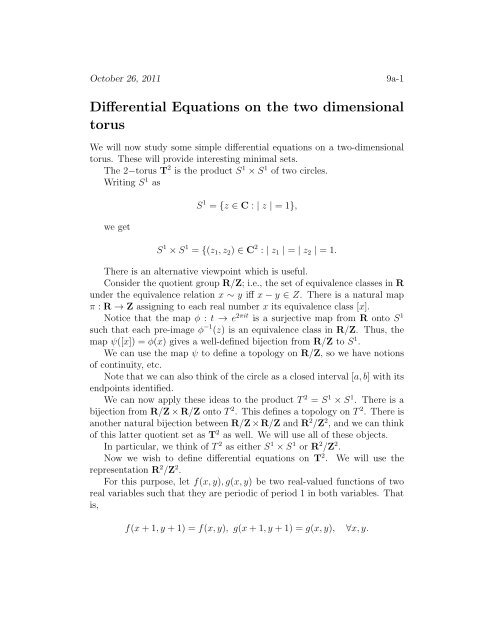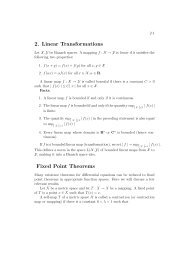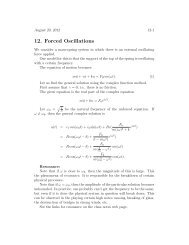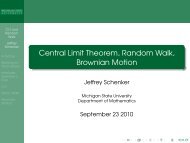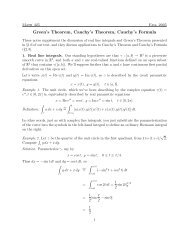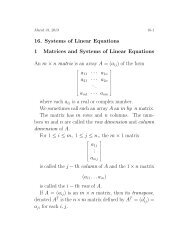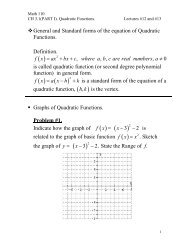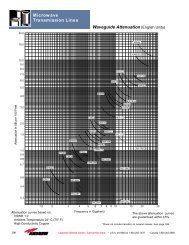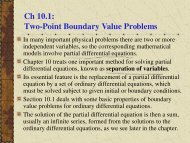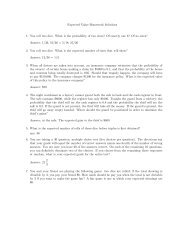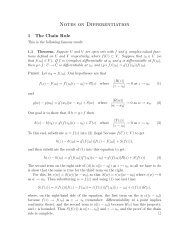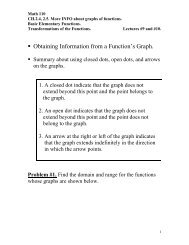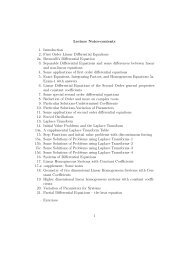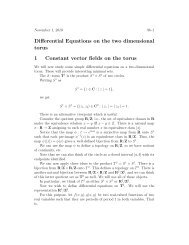Differential Equations on the two dimensional torus
Differential Equations on the two dimensional torus
Differential Equations on the two dimensional torus
You also want an ePaper? Increase the reach of your titles
YUMPU automatically turns print PDFs into web optimized ePapers that Google loves.
October 26, 2011 9a-1<str<strong>on</strong>g>Differential</str<strong>on</strong>g> <str<strong>on</strong>g>Equati<strong>on</strong>s</str<strong>on</strong>g> <strong>on</strong> <strong>the</strong> <strong>two</strong> dimensi<strong>on</strong>al<strong>torus</strong>We will now study some simple differential equati<strong>on</strong>s <strong>on</strong> a <strong>two</strong>-dimensi<strong>on</strong>al<strong>torus</strong>. These will provide interesting minimal sets.The 2−<strong>torus</strong> T 2 is <strong>the</strong> product S 1 × S 1 of <strong>two</strong> circles.Writing S 1 aswe getS 1 = {z ∈ C : | z | = 1},S 1 × S 1 = {(z 1 , z 2 ) ∈ C 2 : | z 1 | = | z 2 | = 1.There is an alternative viewpoint which is useful.C<strong>on</strong>sider <strong>the</strong> quotient group R/Z; i.e., <strong>the</strong> set of equivalence classes in Runder <strong>the</strong> equivalence relati<strong>on</strong> x ∼ y iff x − y ∈ Z. There is a natural mapπ : R → Z assigning to each real number x its equivalence class [x].Notice that <strong>the</strong> map φ : t → e 2πit is a surjective map from R <strong>on</strong>to S 1such that each pre-image φ −1 (z) is an equivalence class in R/Z. Thus, <strong>the</strong>map ψ([x]) = φ(x) gives a well-defined bijecti<strong>on</strong> from R/Z to S 1 .We can use <strong>the</strong> map ψ to define a topology <strong>on</strong> R/Z, so we have noti<strong>on</strong>sof c<strong>on</strong>tinuity, etc.Note that we can also think of <strong>the</strong> circle as a closed interval [a, b] with itsendpoints identified.We can now apply <strong>the</strong>se ideas to <strong>the</strong> product T 2 = S 1 × S 1 . There is abijecti<strong>on</strong> from R/Z × R/Z <strong>on</strong>to T 2 . This defines a topology <strong>on</strong> T 2 . There isano<strong>the</strong>r natural bijecti<strong>on</strong> between R/Z × R/Z and R 2 /Z 2 , and we can thinkof this latter quotient set as T 2 as well. We will use all of <strong>the</strong>se objects.In particular, we think of T 2 as ei<strong>the</strong>r S 1 × S 1 or R 2 /Z 2 .Now we wish to define differential equati<strong>on</strong>s <strong>on</strong> T 2 . We will use <strong>the</strong>representati<strong>on</strong> R 2 /Z 2 .For this purpose, let f(x, y), g(x, y) be <strong>two</strong> real-valued functi<strong>on</strong>s of <strong>two</strong>real variables such that <strong>the</strong>y are periodic of period 1 in both variables. Thatis,f(x + 1, y + 1) = f(x, y), g(x + 1, y + 1) = g(x, y), ∀x, y.
October 26, 2011 9a-2The planar vector field X(x, y) = (f(x, y), g(x, y)) is a map from R 2 →R 2 . The periodicity c<strong>on</strong>diti<strong>on</strong>s imply that it induces a well-defined map fromR 2 /Z 2 to R 2 . We call this a vector field <strong>on</strong> <strong>the</strong> <strong>torus</strong> T 2 . The associatedsystem of differential equati<strong>on</strong>sẋ = f(x, y)ẏ = g(x, y)is called a differential equati<strong>on</strong> <strong>on</strong> T 2 .The soluti<strong>on</strong>s (or orbits) are obtained by taking <strong>the</strong> orbits in R 2 andprojecting <strong>the</strong>m down to T 2 .Let us take a simple example.C<strong>on</strong>sider <strong>the</strong> c<strong>on</strong>stant vector field in R 2X(x, y) = ω 1 ∂ x + ω 2 ∂ y ,where ω 1 , ω 2 are positive real numbers.The associated system of differential equati<strong>on</strong>s isẋ = ω 1ẏ = ω 2(1)The periodicity c<strong>on</strong>diti<strong>on</strong>s are obviously satisfied, so we get a differentialequati<strong>on</strong> <strong>on</strong> T 2 . This is called <strong>the</strong> c<strong>on</strong>stant or linear vector field <strong>on</strong> T 2 .Let’s us c<strong>on</strong>sider its orbits.The soluti<strong>on</strong>s to (1) in R 2 are <strong>the</strong> linesx(t) = ω 1 t + c 1 , y(t) = ω 2 t + c 2 .Each such line has slope ω 2ω 1and passes through <strong>the</strong> point (c 1 , c 2 ).On <strong>the</strong> <strong>torus</strong> T 2 we simply take (x(t), y(t)) mod 1.We have <strong>two</strong> main cases:1. 2ω 1is rati<strong>on</strong>al. Write it as 2ω 1= p in lowest terms with p, q positiveqintegers.C<strong>on</strong>sider <strong>the</strong> orbit γ 0 in R 2 through (0, 0) (i.e., c 1 = c 2 = 0).The soluti<strong>on</strong> in R 2 has <strong>the</strong> formx(t) = ω 1 t, y(t) =( pq)ω 1 t
October 26, 2011 9a-3Let π : R 2 → T 2 denote <strong>the</strong> can<strong>on</strong>ical projecti<strong>on</strong>.When t = q/ω 1 , we have x(t) = q, y(t) = p, so <strong>the</strong> projecti<strong>on</strong> π(γ 0 ) = γinto T 2 is a closed curve (topological circle) in T 2 .Since all <strong>the</strong> soluti<strong>on</strong>s are vertical tranlates of γ 0 we have that allsoluti<strong>on</strong>s in T 2 are periodic of <strong>the</strong> same period.2. ω 2ω 1is irrati<strong>on</strong>al.This case is more interesting. We will show that every orbit in T 2 isdense in T 2 . Hence, all of T 2 is a minimal set.Let us show that <strong>the</strong> orbit through (0, 0) is dense in T 2 . The analogousstatement for o<strong>the</strong>r orbits is similar.C<strong>on</strong>sider <strong>the</strong> circle S 1 = π({x = 0}).There is a first return map F : S 1 → S 1 (also called Poincaré map)obtained by taking a point (0, y) and taking <strong>the</strong> point (1, F (y)) where<strong>the</strong> orbit through (0, y) hits <strong>the</strong> line {x = 1}.Let us compute F .The orbit through (0, y) is {(ω 1 t, ω 2 t + y), t ∈ R}.We getHence,ω 1 t = 1ω 2 t + y = F (y).t = 1/ω 1 , F (y) = y + ω 2 /ω 1So, letting α = ω 2ω 1we get that F (y) = y + α (mod 1).To show that <strong>the</strong> orbits of X are dense, it suffices to show that <strong>the</strong>iterates {F n (y), n ≥ 0} are dense mod 1This is <strong>the</strong> number <strong>the</strong>oretic statement: for α irrati<strong>on</strong>al, and<strong>the</strong>nA = {nα + m : n ∈ Z, m ∈ Z},
October 26, 2011 9a-4This elementary fact is proved as follows.(a) A is clearly an additive subgroup of R.A is dense in R. (2)(b) To show that A is dense, it suffices to show that 0 is an accumulati<strong>on</strong>point of A.(c) For this latter fact, for each n ∈ Z, let m n ∈ Z be such thatx n = nα + m n ∈ [0, 1). Since α is irrati<strong>on</strong>al, <strong>the</strong> numbers x n areall distinct. Since [0, 1] is compact, <strong>the</strong>re is a subsequence x ni of(x n ) which c<strong>on</strong>verges. In particular, if ɛ > 0 is arbitrary, <strong>the</strong>re arepoints x n1 , x n2 such that| x n1 − x n2 | < ɛ.But <strong>the</strong>n this difference x n1 − x n2 is in A ⋂ (−ɛ, ɛ). Since, ɛ isarbitrary, we have that 0 is an accumulati<strong>on</strong> point of A as required.Let us now give an applicati<strong>on</strong> of <strong>the</strong>se ideas.C<strong>on</strong>sider <strong>the</strong> mass spring system whose equati<strong>on</strong> ismẍ + kx = 0where m is <strong>the</strong> mass of an object suspended vertically by a spring,k > 0 is <strong>the</strong> spring c<strong>on</strong>stant, and x = 0 represents <strong>the</strong> equilibriumpositi<strong>on</strong>.√Let ω = k. The associated first order planar system can be writtenmẋ = −ω yẏ = ω x(3)Let us write this system (3) in polar coordinates.We havex = rcos(θ), y = rsin(θ)
October 26, 2011 9a-5ẋ = ṙcos(θ) − rsin(θ) ˙θẏ = ṙsin(θ) + rcos(θ) ˙θ(4)So, we see that <strong>the</strong> simple polar coordinate systemṙ = 0˙θ = ω(5)is equivalent to (4).The soluti<strong>on</strong>s off (0, 0) arer = c > 0, θ(t) = ω t + θ 0 .Hence, <strong>the</strong> orbits in <strong>the</strong> plane off (0, 0) c<strong>on</strong>sist of <strong>the</strong> circles r = c and<strong>the</strong> moti<strong>on</strong> has c<strong>on</strong>stant rotati<strong>on</strong>al speed ω with period 2π ω .Now, c<strong>on</strong>sider <strong>two</strong> uncoupled springs whose equati<strong>on</strong>s in R 4 becomex˙1 = −ω 1 y 1y˙1 = ω x 1(6)x˙2 = −ω 2 y 2y˙2 = ω 2 x 2Using polar coordinates (r 1 , θ 1 , r 2 , θ 2 ) in R 4 in <strong>the</strong> obvious way, we get<strong>the</strong> equivalent equati<strong>on</strong>sr˙1 = 0θ˙1 = ω 1(7)r˙2 = 0θ˙2 = ω 2Hence all soluti<strong>on</strong>s in R 4 off <strong>the</strong> uni<strong>on</strong> of <strong>the</strong> <strong>two</strong> subspaces R 2 ×{(0, 0} ⋃ {0, 0}×R 2 lie <strong>on</strong> <strong>two</strong> dimensi<strong>on</strong>al tori r 1 = c 1 , r 2 = c 2 , and <strong>the</strong> moti<strong>on</strong> <strong>on</strong> each is ac<strong>on</strong>stant vector field. If ω 2 /ω 1 is rati<strong>on</strong>al, <strong>the</strong>n all <strong>the</strong>se orbits are periodic,and if ω 2 /ω 1 is irrati<strong>on</strong>al, <strong>the</strong>n all <strong>the</strong>se tori are minimal sets.


